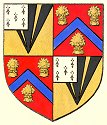 |
A SHORT HISTORY OF TETTENHALL7. The eighteenth century |
|
 |
A SHORT HISTORY OF TETTENHALL7. The eighteenth century |
|
In the eighteenth century Tettenhall remained an agricultural village but this was an age of expansion and Tettenhall expanded and developed too. In 1707 the Creswell almshouses were opened in Lower Street and in 1714 Brych House in Wrotteseley Road was bought and turned into the village workhouse. In 1776 there was a school in the village and there may have been one earlier than that.
Some villagers
were looking beyond agriculture and the parish records show, in addition
to farmers, husbandmen, yeomen, farm labourers, woodcutters and millers,
a selection of more industrial workers: locksmiths, buckle makers,
cordwainers, hinge makers, weavers, coal carriers, brush makers, watch
chain makers, nailers, tile makers and screw filers. How many of these
men worked locally and how many walked into Wolverhampton each day, one
cannot say. |